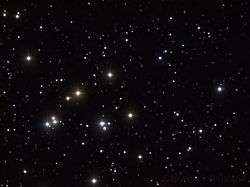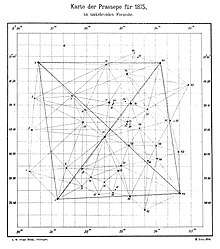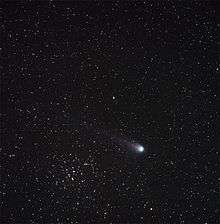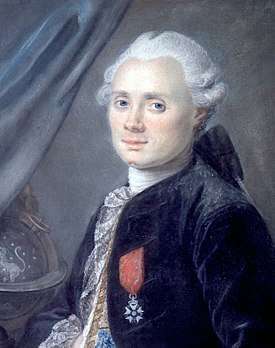Beehive Cluster
The Beehive Cluster (also known as Praesepe (Latin for "manger"), M44, NGC 2632, or Cr 189), is an open cluster in the constellation Cancer. It is one of the nearest open clusters to Earth, containing a larger population of stars than other nearby bright open clusters. Under dark skies, the Beehive Cluster looks like a small nebulous object to the naked eye; as known since ancient times. Classical astronomer Ptolemy described it as "nebulous mass in the breast of Cancer", and it was among the first objects that Galileo studied with his telescope.[3]
| Messier 44 / Beehive Cluster | |
|---|---|
 The Beehive Cluster is an open cluster in Cancer just visible to the naked eye. | |
| Observation data (J2000.0 epoch) | |
| Constellation | Cancer |
| Right ascension | 08h 40.4m |
| Declination | 19° 59′ |
| Distance | 610 ly [1] (187 pc) |
| Apparent magnitude (V) | 3.7[2] |
| Apparent dimensions (V) | 95′ |
| Physical characteristics | |
| Mass | ~500–600 M☉ |
| Estimated age | ~600–700 million years |
| Other designations | Praesepe, M44, NGC 2632, Cr 189 |
Age and proper motion coincide with those of the Hyades, suggesting they may share similar origins.[4][5] Both clusters also contain red giants and white dwarfs, which represent later stages of stellar evolution, along with many main sequence stars.
Distance to M44 is often cited to be between 160 and 187 parsecs (520–610 light years),[6][7][8] but the revised Hipparcos parallaxes (2009) for Praesepe members and the latest infrared color-magnitude diagram favors an analogous distance of 182 pc.[9][10] There are better age estimates of around 600 million years,[5][7][11] equivalent to about 625 million years, for the Hyades.[12] The diameter of the bright inner cluster core is about 7.0 parsecs (23 light years).[11]
Observationally, the Beehive is easily visible to the naked eye as a small nebulous cloud when Cancer culminates in the early evening sky each year from February to May. At 1.5° across, the cluster easily fits within the field of view of binoculars or low-powered small telescopes.
History
In 1609, Galileo first telescopically observed the Beehive and was able to resolve it into 40 stars. Charles Messier added it to his famous catalog in 1769 after precisely measuring its position in the sky. Along with the Orion Nebula and the Pleiades cluster, Messier's inclusion of the Beehive has been noted as curious, as most of Messier's objects were much fainter and more easily confused with comets. Another possibility is that Messier simply wanted to have a larger catalog than his scientific rival Lacaille, whose 1755 catalog contained 42 objects, and so he added some well-known bright objects to boost his list.[13] Wilhelm Schur, as director of the Göttingen Observatory, drew a map of the cluster in 1894.

Ancient Greeks and Romans saw this object as a manger from which two donkeys, the adjacent stars Asellus Borealis and Asellus Australis, are eating; these are the donkeys that Dionysos and Silenus rode into battle against the Titans.[14]
Hipparchus (c.130 BC) refers to the cluster as Nephelion ("Little Cloud") in his star catalog.[15] Claudius Ptolemy's Almagest includes the Beehive Cluster as one of seven "nebulae" (four of which are real[16]), describing it as "The Nebulous Mass in the Breast (of Cancer)".[17] Aratus (c.260–270 BC) calls the cluster Achlus or "Little Mist" in his poem Phainomaina.[15]
This perceived nebulous object is in the Ghost (Gui Xiu), the 23rd lunar mansion of ancient Chinese astrology. Ancient Chinese skywatchers saw this as a ghost or demon riding in a carriage and likened its appearance to a "cloud of pollen blown from willow catkins". It was also known by the somewhat less romantic name of Jishi qi (積屍氣, also transliterated Tseih She Ke), the "Exhalation of Piled-up Corpses".[15] It is also known simply as Jishi (積屍), "cumulative corpses".
Morphology and composition
Like many star clusters of all kinds, Praesepe has experienced mass segregation.[7][11][18] This means that bright massive stars are concentrated in the cluster's core, while dimmer and less massive stars populate its halo (sometimes called the corona). The cluster's core radius is estimated at 3.5 parsecs (11.4 light years); its half-mass radius is about 3.9 parsecs (12.7 light years); and its tidal radius is about 12 parsecs (39 light years).[7][11] However, the tidal radius also includes many stars that are merely "passing through" and not bona fide cluster members.
Altogether, the cluster contains at least 1000 gravitationally bound stars, for a total mass of about 500–600 Solar masses.[7][11] A recent survey counts 1010 high-probability members, of which 68% are M dwarfs, 30% are Sun-like stars of spectral classes F, G, and K, and about 2% are bright stars of spectral class A.[7] Also present are five giant stars, four of which have spectral class K0 III and the fifth G0 III.[4][7][19]
So far, eleven white dwarfs have been identified, representing the final evolutionary phase of the cluster's most massive stars, which originally belonged to spectral type B.[5] Brown dwarfs, however, are extremely rare in this cluster,[20] probably because they have been lost by tidal stripping from the halo.[7]
The cluster has a visual brightness of magnitude 3.7. Its brightest stars are blue-white and of magnitude 6 to 6.5. 42 Cancri is a confirmed member.

Planets
In September, 2012 two planets which orbit separate stars were discovered in the Beehive Cluster. The finding was significant for being the first planets detected orbiting stars like Earth's Sun that were situated in stellar clusters. Planets had previously been detected in such clusters, but not orbiting stars like the Sun.
The planets have been designated Pr0201 b and Pr0211 b. The 'b' at the end of their names indicates that the bodies are planets. The discoveries are what have been termed Hot Jupiters, massive gas giants that, unlike the planet Jupiter, orbit very close to their parent stars.
The announcement describing the planetary finds, written by Sam Quinn as the lead author, was published in the Astrophysical Journal Letters. Quinn's team worked with David Latham of the Harvard-Smithsonian Center for Astrophysics, utilizing the Smithsonian Astrophysical Observatory's Fred Lawrence Whipple Observatory.[21]
In 2016 additional observations concluded that in the Pr0211 system there are actually two planets, the second one being Pr0211 c.[22]
References
- "NGC 2632". sim-id. Retrieved 2020-06-11.
- "Messier 44". SEDS. Retrieved 2009-12-10.
- "Messier 44: Observations and Descriptions".
- Klein-Wassink, W.J. (1927). "The proper motion and the distance of the Praesepe cluster". Publications of the Kapteyn Astronomical Laboratory Groningen. 41: 1–48. Bibcode:1927PGro...41....1K.
- Dobbie PD; Napiwotzki R; Burleigh MR; et al. (2006). "New Praesepe white dwarfs and the initial mass-final mass relation". Monthly Notices of the Royal Astronomical Society. 369 (1): 383–389. arXiv:astro-ph/0603314. Bibcode:2006MNRAS.369..383D. doi:10.1111/j.1365-2966.2006.10311.x.
- Pinfield DJ; Dobbie PD; Jameson F; Steele IA; et al. (2003). "Brown dwarfs and low-mass stars in the Pleiades and Praesepe: Membership and binarity". Monthly Notices of the Royal Astronomical Society. 342 (4): 1241–1259. arXiv:astro-ph/0303600. Bibcode:2003MNRAS.342.1241P. doi:10.1046/j.1365-8711.2003.06630.x.
- Kraus AL; Hillenbrand LA (2007). "The stellar populations of Praesepe and Coma Berenices". Astronomical Journal. 134 (6): 2340–2352. arXiv:0708.2719. Bibcode:2007AJ....134.2340K. doi:10.1086/522831.
- WEBDA
- van Leeuwen, F. "Parallaxes and proper motions for 20 open clusters as based on the new Hipparcos catalogue", A&A, 2009
- Majaess, D.; Turner, D.; Lane, D.; Krajci, T. "Deep Infrared ZAMS Fits to Benchmark Open Clusters Hosting delta Scuti Stars", Journal of the American Association of Variable Star Observers, 2011
- Adams JD; Stauffer JR; Skrutskie MF; et al. (2002). "Structure of the Praesepe Star Cluster". Astronomical Journal. 124 (3): 1570–1584. Bibcode:2002AJ....124.1570A. doi:10.1086/342016.
- Perryman M; Brown A; Lebreton Y; Gomez A; Turon C; Cayrel de Strobel G; et al. (1998). "The Hyades: Distance, structure, dynamics, and age". Astronomy & Astrophysics. 331: 81–120. arXiv:astro-ph/9707253. Bibcode:1998A&A...331...81P.
- Frommert, Hartmut (1998). "Messier Questions & Answers". SEDS. Archived from the original on 9 February 2005. Retrieved 2005-03-01.
- "M44". SEDS. Retrieved 2005-02-06.
- Allen, Richard Hinckley (1889). Star Names. p. 112.
- "The Discovery of the Deep Sky Objects".
- "Messier Object 44". SEDS. Retrieved 2013-09-28.
- Portegies Zwart SF; McMillan SL; Hut P; Makino J (2001). "Star cluster ecology IV. Dissection of an open star cluster: Photometry". Monthly Notices of the Royal Astronomical Society. 321 (2): 199–226. arXiv:astro-ph/0005248. Bibcode:2001MNRAS.321..199P. doi:10.1046/j.1365-8711.2001.03976.x.
- Abt HA; Willmarth DW (1999). "Binaries in the Praesepe and Coma star clusters and their implications for binary evolution". Astrophysical Journal. 521 (2): 682–690. Bibcode:1999ApJ...521..682A. doi:10.1086/307569.
- Gonzalez-Garcia BM; Zapatero Osorio MR; Bejar VJS; Bihain G; et al. (2006). "A search for substellar members in the Praesepe and Sigma Orionis clusters". Astronomy & Astrophysics. 460 (3): 799–810. arXiv:astro-ph/0609283. Bibcode:2006A&A...460..799G. doi:10.1051/0004-6361:20065909.
- "First Planets Found Around Sun-Like Stars in a Cluster". Retrieved September 14, 2012.
- Malavolta, L.; et al. (2016). "The GAPS programme with HARPS-N at TNG". Astronomy & Astrophysics. 588: A118. arXiv:1602.00009. doi:10.1051/0004-6361/201527933. Retrieved 2016-04-19.
External links
| Wikimedia Commons has media related to |
- M44 Photo detail Dark Atmospheres
- Messier 44, SEDS Messier pages
- NightSkyInfo.com – M44, the Beehive Cluster
- NASA Astronomy Picture of the Day: M44: A Beehive of Stars (3 August 1998)
- The Beehive Cluster on WikiSky: DSS2, SDSS, GALEX, IRAS, Hydrogen α, X-Ray, Astrophoto, Sky Map, Articles and images
- Praesepe (M44) at Constellation Guide
